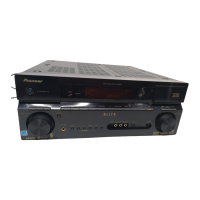
Do you have a question about the Pioneer Elite VSX-80TXV-S and is the answer not in the manual?
| Channels | 7.1 |
|---|---|
| HDMI Outputs | 1 |
| Audio D/A Converter | 192 kHz / 24-bit |
| Input Sensitivity | 200 mV |
| Tuner Bands | AM/FM |
| HDMI Switching | Yes |
| Audio Formats Supported | Dolby Digital, DTS, DTS-ES Matrix, DTS 96/24, DTS Neo:6 |
| Zone 2/Zone 3 Control | Zone 2 |
| Input Impedance | 47 kΩ |
| Frequency Response | 5 Hz - 100 kHz |
| Bass Control | Yes |
| Treble Control | Yes |
| Tuning Range | AM: 530 - 1700 kHz, FM: 87.5 - 108 MHz |
| Speaker Impedance | 6 Ω |
Essential guidelines for safe operation, including handling, cleaning, and placement.
Instructions on proper plug insertion and grounding for electrical safety.
Guidelines on when to seek professional servicing and precautions for damaged units.
Overview of advanced features and technologies of the receiver.
Basic steps for setting up and listening to surround sound audio.
Guide to using the MCACC system for automatic speaker calibration and room optimization.
Basic instructions for selecting and playing audio/video sources through the receiver.
Information on connecting high-definition digital video and audio using HDMI cables.
Inputs for connecting sources with multichannel analog audio outputs.
Connection points for front, center, surround, and surround back speakers.
Step-by-step guide for connecting TV and DVD player to the receiver.
Instructions for connecting set-top boxes for satellite or cable TV.
Instructions for connecting various video recording and playback devices.
Guide to connecting components using component video for superior picture quality.
Guide to connecting digital audio components for playback and recording.
Instructions for connecting analog audio-only sources, such as CD players.
Comprehensive guide to connecting and installing front, center, surround, and subwoofer speakers.
How to properly connect speaker wires to the receiver's terminals.
Guidelines for optimal speaker placement to achieve the best surround sound effect.
Guidelines for setting up speakers for THX certified home theater systems.
Explanation of all buttons, dials, and indicators on the receiver's front panel.
Overview of remote control buttons, functions, and color-coding for component control.
How the receiver automatically selects playback modes based on the source.
Methods for experiencing surround sound from various sources and speaker setups.
Using EQ settings to optimize speaker response based on room acoustics.
Options for enabling or disabling surround back channel processing for 5.1/6.1/7.1 sources.
Navigating the System Setup menu for customizing receiver functions and settings.
Options for utilizing surround back speaker terminals for various setups.
Detailed manual adjustments for speaker settings and Acoustic Calibration EQ.
Adjusting individual speaker channel levels for optimal balance and surround sound.
Setting precise speaker delay distances for accurate sound depth and separation.
Using EQ settings to optimize speaker response based on room acoustics.
Guide to automatically applying EQ settings based on room acoustics.
Manually adjusting EQ settings for precise frequency balance.
Detailed configuration of speaker sizes, quantities, and levels for optimal performance.
Specifying speaker sizes (Large/Small) and quantities for proper system configuration.
Adjusting the overall balance of speaker system levels for optimal sound.
Setting speaker delay distances for accurate sound depth and separation.
Steps for connecting HDMI or DVI-equipped components for high-definition audio/video.
How to assign specific digital, component, and HDMI inputs to receiver functions.
Programming the remote to operate other audio/video components using preset codes or learning.
Teaching the remote to learn commands from original component remotes.
A comprehensive guide to diagnosing and resolving common operational issues.
Solutions for problems related to the receiver not turning on or shutting off unexpectedly.
Troubleshooting steps for scenarios where no sound is output from speakers or specific channels.
